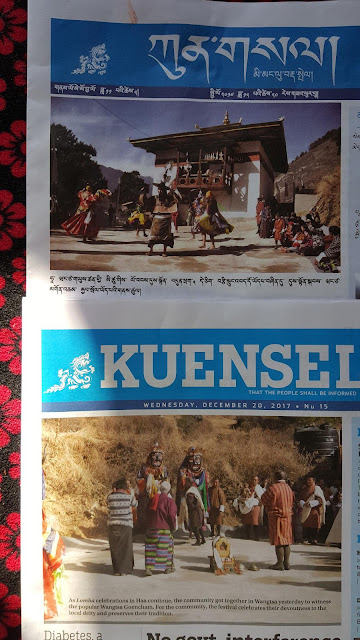Every once in a while a Ministry or a dzongkhag administration or a local government ( this time in Shemgang ) comes up with rules on how Bhutanese people should be dressed and punished. This kind of official tone has become a disease for social illness rather than any relief for nation enhancement. If the unemployed youths are given sustainable jobs in the like manner of orders of official threats and penalties about culture and code of conduct are issued, there would be no idle youths, no drug problems and possibly no suicides either. How wonderful !
National dress should never be used as a tool of politics or as a whip of social disciplining. Any Governnent or political leaders that endorses or allows enforcement of such disciplinary regulations into the homes and daily lives of general citizens would be promoting the sense of social fear and oppression. To what end ?
It was partly the blind enforcements by Dzongkhag officials of such rules and regulations right into the homes and fields that made it possible for anti- nationals to incite social upheavals in South Bhutan. Bhutanese authorities must understand and realise that the end result of such official repressions can be either serfdom for the populace or forced rebellion. Neither is desirable for the People, the Royal blessed democratic system and the cherished institution of Monarchy.
It is possible that some of our local government elected officials and appointed dzongkhag administrators are playing into the hands of anti national forces or they are by intent manipulating cultural ideals to ruin the fledging democractic system.
I hope the central authority and leaders respect the wisdom of prevailing status-quo. Our culture, tradition, the institutions of Monarchy and Dharma are central features of the Bhutanese nation. It would be unhealthy to attempt to drown the 700,000 Bhutanese in one particular heritage. Bhutanese authorities at central or dzongkhag level need to refrain from promoting a repressive social condition. Such a path contradicts the precious gnh philosphy and much cherished image of benevolence at the highest level.
Culture wise, the nation is very healthy. Bhutanese in general are proud of our culture and are most respectful to authorities. We understand the importance of national identity of our culture and are very much aware of the central role of the Monarchy for the sovereignty and stability of the Bhutanese nation. Bhutanese in general zealously guard our way of life and soveriegnty with much pride and determination. The opposition to BBIN Agreement was one such expression of unified national aspiration. Too much cultural dictates and penalties would kill national inspirations and aspirations.
Now national attention and energy must be directed where improvements and enhancements are most needed.
Life of a nation is much more than attires, disciplines and reverence.
His Majesty the King as well as the voice of majority of the people are for better education; more employment opportunities; reduction in problems of drug addiction of youths; reducing the ills of spiralling divorce trends and alcohol menaces.
The prevailing national administration scene calls for tackling the monumental institutionalised monetary corruptions in financial institutions, ministries, agencies and corporations; fighting misuses of power and influence and bribes in many sectors ; combating systematic manipulations of land transactions and so on.
The only benefit the authorities would gain from repressive policies in the name of culture would be a brief respite for their corrupt acts including mismanagement of development funds and official positions. There is no benefit to the larger national interest.
Besides the objective to subjugate the will of the people, it seems that the fascination of some leaders with gho, kira and kamni is rooted in two personal agendas. One seems to be a ploy to cover up short-comings in their professional and official responsibilities through outward act of nationalism. And the other seems to be to remind the people of their low social status so as to maximise the full powerful impact of kamni and patang attire of officials " from 9am to 5pm." Much like an exhibition of superior natural endowments by the peacock to a congregation of peahens devoid of colours and dazzles. Could such be the original fundamentals of knighthood tradition in feudal Europe?
